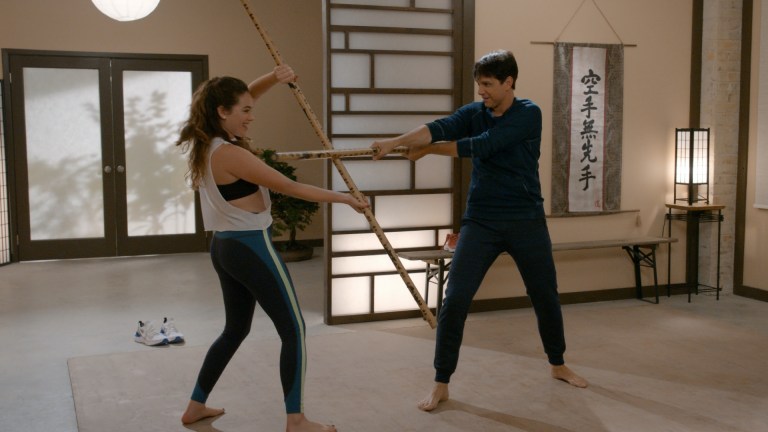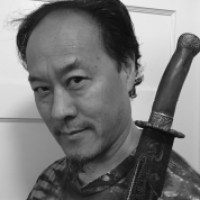Cobra Kai: How the Show’s Martial Arts Level Up in Season 3
Den of Geek talks to Ralph Macchio, Jacob Bertrand, Peyton List, Mary Mouser, and Xolo Maridueña about tuning up their karate skills for Cobra Kai season 3.

This article contains Cobra Kai season 3 spoilers.
Despite its iconic standing within the martial arts genre, the martial arts in The Karate Kid have never been outstanding. Sure, the crane kick is a classic, but from a technical standpoint, it’s not that impressive. Ralph Macchio had no martial arts training prior to undertaking the role of Daniel. In many ways, that’s part of the charm. Whether you know martial arts or not, Daniel’s wax on, wax off awkwardness makes Macchio’s portrayal more genuine.
Throughout the film franchise, it was Daniel’s adversaries who were the martial artists. William Zabka (Johnny Lawrence) had a background in wrestling prior to the first film and continued to train in Tang Soo Do under Master Pat E. Johnson after it wrapped (Johnson played the referee and trained the actors for the film.) Martin Kove (John Kreese) studied Gosoku-ryu Karate under the founder of that style, Grandmaster Takayuki Kubota. The villains in the sequels all had previous training too. Yuji Okumoto (Chozen Toguchi) began Chito-ryu Karate when he was thirteen and was a brown belt by the time he appeared in The Karate Kid Part II. In The Karate Kid Part III, Thomas Ian Griffith (Terry Silver) practiced Taekwondo since childhood and holds a black belt in Kenpo Karate. Stage combat is one of his specialties. And Sean Kanen (Mike Barnes), like Okumoto, studied Karate since he was thirteen, only his style was Shotokan. He also worked professionally as a bar bouncer.
Because Macchio was a much weaker martial artist than his adversaries both in the story and reality, it was challenging for the stunt choreographers. It limits the vocabulary of where the fights could go. Without a strong martial artist in the lead role, the fight choreographers had to create work arounds, like the crane kick. But again, that was part of the charm of Daniel. No one could play Daniel LaRusso like Ralph Macchio.
Cobra Kai faces a similar situation because like Macchio, few of the lead actors had previous martial arts training. For more authenticity, newcomers to the cast were not only tasked to learn Karate, they had to do some of their own stunts. With that in mind, Den of Geek spoke with Macchio and more about season 3’s ambitious combat, and the training and editing that goes into major fight scenes.
No Mercy
Cobra Kai suffers from the same constraint as the original films had with Daniel. All the high school kids are amateurs. We bear witness to their inductions into Karate, and their meteoric rise in skills (Just like The Karate Kid, Cobra Kai takes major liberties on how quickly someone can progress in the martial arts, but so do most stories in the genre). They’re teenagers, not ninjas or Shaolin monks. The fight scenes cannot pivot on extreme Jackie Chan moves. To remain genuine to the story, the next generation must retain some of Daniel’s awkwardness.
However, stunt coordinators Jahnel Curfman and Hiro Koda did excellent work in keeping it real. In the premiere episode, Johnny’s first fight showed that Zabka had kept up on his Tang Soo Do and could still throw a decent kick. It served the story perfectly, showing Johnny as slightly out of shape, but still formidable. As seasons 1 and 2 progressed, the fight choreography complemented its story arcs appropriately, but Cobra Kai wasn’t a show just to watch for its fight scenes.
This changed with the season 2 finale “No Mercy.” Curfman and Koda composed a thrilling high school brawl with a solid long take shot – a “one-er” where there are no cuts in the action. It was a thrilling fight, full of complex cinematography and enough close-ups that we could see that many of the actors did their own stunts.
The season 3 finale fight in the LaRusso residence was even better, longer, and more complex. According to Xolo Maridueña (Miguel), Cobra Kai’s second one-er was a challenge. “When you film an episode like the finale of season 2, you get to the point where you’re like, ‘How do we top this?’ It feels like we kind of achieved everything that we wanted. And I think at that point, we did achieve everything that we wanted. We got this really, really great scene that felt so grand. And in season 3, we want to give people that same kind of feeling, that same rush that you get from watching so many moving parts working together, but it needs to be different.”
How was it different? Maridueña elaborates. “I think that you see that the motives of a lot of these characters are different. The circumstances, the need to win I think is much higher in a finale. And I think up until the very end and even after the fight feels concluded you still feel that sense of weight on your shoulders.”
The Long Take One-Er
Cuts make fight choreography easier. When there’s one cut for every strike, retakes aren’t as difficult. If there are two strikes before a cut, it’s twice as hard. More strikes increase the challenge exponentially. In the original film, The Karate Kid, there was a one-er, but it wasn’t a fight scene. When Daniel first enters the All-Valley Karate Tournament from the locker room, it’s a continuous long take that clocks in just shy of a minute and a half. The blocking is complicated but it’s not as complex as a fight scene would be, and according to Macchio, the scene took 35 takes to get right.
In filmmaking, one-ers are always held in high regard for their technical achievement. Hitchcock’s Rope was a pioneering example with the entire film consisting of only 11 one-ers. The critically acclaimed World War I film 1917 was nearly a single one-er. When it comes to fight choreography, this is why classic Kung Fu films from the 70s and 80s are so highly respected by martial art movie connoisseurs. While they weren’t one-ers, those fights, like what was coming out of Shaw Brothers Studio, went dozens of moves before a cut. Some recent films like Atomic Blonde and the John Wick trilogy have showcased one-er fights. What’s more, they are shot in such a way that we can see that Keanu Reeves and Charlize Theron are doing a lot of their own stunts. In contrast, in Netflix’s latest assassin thriller Ava, all of Jessica Chastain’s fights are one strike, one shot, and her stuntperson takes over for all the heavy lifting.
There are some trade tricks to one-ers. The first is a stitch where the camera pans to a featureless surface. This can disguise a covert cut, making the scene appear seamless. But in actuality, there was a break. The other is what is known in the stunt industry as a “Texas switch.” This is where an actor is swapped out with a stunt person by somehow leaving the shot, like being tossed out of frame or ducking behind an obscuring set piece.
Television fight choreography has leveled up in the last few years. Daredevil was a game-changer for TV one-ers. The show kept upping its game every season. Season 1 episode 2 “Cut Man” ended with a one-er hallway fight that caught every martial arts fan’s attention. It had a lot of stitches and Texas switches. During that one-er, the camera repeatedly moves across featureless hallway walls hiding cuts and Daredevil is masked, allowing for multiple stuntmen to take over. Nevertheless, it’s still a thrilling fight and top-notch choreography. Season 2 episode 3 “New York’s Finest” featured another brutal one-er in a staircase fight. Again, Daredevil is masked so swapping stuntmen was easy. On top of that, Daredevil knocks out the lights, so a lot of the fight is in the dark, obscuring more stitches and switches. In Season 3 episode 4 ‘Blindsided’ Daredevil pulled off their most spectacular one-er of all and one of the best that has ever made it to the small screen so far, the prison fight. In that scene, Daredevil is not masked so Charlie Cox can be seen doing a lot of his own stunts. It clocks in at over 10 minutes. The fight choreographers on Daredevil, Chris Brewster, Philip Silvera, and Roberto Gutierrez raised the bar on TV fight choreography.
Karate And Stunt Training
The one-ers in Cobra Kai aren’t nearly as long, but they do showcase the actors doing many of their own stunts. And like Macchio, few of the cast have had previous training. Jacob Bertrand (Hawk) has a purple belt in Karate and Taylor Buchanan dabbled in Taekwondo, but that’s about the extent of the young cast’s experience. Beyond learning their lines and finding their characters, the actors had to take a crash course in martial arts.
“I only started learning in season 2,” says Peyton List (Tory), “and that was just in episode 4 of season 2, when I first came in. And I just take everything I can get, and I love learning it. So I’m trying to do everything I can even from home, but that one-er was one of the most fun. Jahnel, my stunt double, she was like, ‘You’re doing this all on your own.’ And that was a big moment for me, and I’m excited for everyone to see that.”
“My training is something I take super seriously,” adds Mary Mouser (Sam), “because I know that a lot of people who watch this show love martial arts and love the fighting aspect. As much as all the other fun things we have, we have a lot of really cool martial arts fans. So I want to make them proud. I am clearly still a novice in this world, but Samantha is not. So it’s fun to get to stretch myself, to see how much I can push myself to look like I’ve been doing Karate for all these years, when in total probably have about a year’s worth of training so far.”
Bertrand’s Karate background doesn’t make shooting a one-er any easier. “The next couple of days after those types of shoots, you’re definitely sore for at least two days. You’re running the same thing over and over again at 110%, but honestly, I’m just so excited for everyone to see that final fight, it’s going to be so great.”
Forever Young
In season 3, Daniel says he’s now as old as Miyagi was when they first met. Despite his baby face, Macchio is 59. He admits doing fight scenes no isn’t as easy as back in the day. “The challenge is always as I get older or attempt to look younger, is the physical stuff. Staying in shape, not getting hurt. It requires work and attention and focus.”
Macchio is like David Carradine, who played Kwai Chang Caine in the television show Kung Fu. For their defining roles, they posed as martial arts masters, however they are actors first and foremost, not martial artists. At the very least, Macchio has maintained his integrity by never claiming to be an expert. Carradine milked his master role by writing martial arts books and selling instructional videos, despite his martial mediocrity. Today, Carradine’s martial products are generally disregarded, even mocked, by earnest practitioners. Most considered them to be a joke (the fact that Carradine’s Kung Fu uniforms looked more like Klingon athleisure suits didn’t help). Macchio could have easily cashed in doing the same but to his credit, he never did.
Will Cobra Kai attempt an even bigger one-er for Season 4? “As soon as the fight is over you’re ready to watch the next one,” teases Maridueña. “And I think that’s all you can ask for in a fight scene.”
Cobra Kai season 3 is now available on Netflix.
